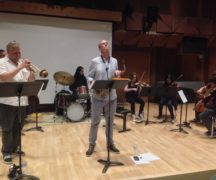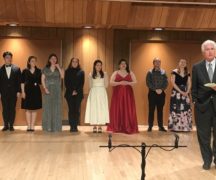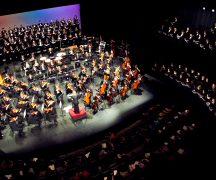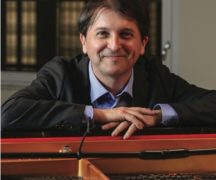By DAVID DUPONT
BG Independent News
Elainie Lillios’ music emerges from a web of relationships.
The composer works closely with the musicians as she’s writing. She meets with the poet whose work inspires her. She reaches beyond music to poetry and art to construct her pieces that merge electronics and acoustic sounds.
All those elements are in play as the Bowling Green State University professor of composition works on her newest piece. “Hazy Moonlight” is being funded by a prestigious Barlow Endowment Commission for Music.
Lillios had already been discussing composing a piece for the duo of percussionist Stuart Gerber and saxophonist Jan Berry Baker before the Barlow Commission. In fact, it was the performers who suggested she apply. Lillios was one of 12 recipients out of 150 applicants.
Lillios had visited them in Atlanta where they were playing on a streetcar during a festival. That’s part of what impressed the composer about the performers.
“Just because music is difficult doesn’t mean it can’t be shared with the community,” she said. “They are very committed to this idea of getting music outside buildings, outside the academy, into places new music necessarily doesn’t happen. … They are really fearless performers. They want to engage with the community.”
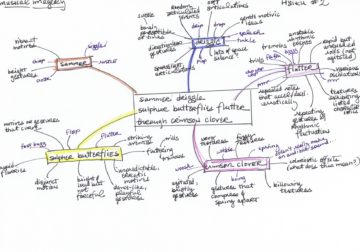
A mind map created by Elainie Lillios for an earlier composition.
Lillios engages the performers from the very beginning of the composition process. “I like to be in a relationship with the people with whom I work. I’m not the kind of composer who goes into my room and spends six months there to write a piece and says ‘here it is’ without having any collaboration during the process.” Lillios wants them to feel “like they’ve been part of the piece from the very beginning.”
Lillios wants to know who the performers’ favorite composers are, particular techniques they like or don’t like, how the piece will fit into their repertoire.
The discussions include logistics as well. What instruments can the percussionist expect to have available while on tour? Lillios already has decided the piece will only use soprano and alto saxophones since that’s what saxophonist Berry Baker carries when she travels.
The piece will use both taped sounds and real time electronic processing of the sounds produced by the performers on stage.
Lillios is in the very earliest stages of the composition process. When writing for instruments, she said, she draws inspiration from poetry, and for “Hazy Moonlight” she’s turning to the work of a favorite writer Wally Swist, of Amherst, Massachusetts.
“He writes very vivid and provocative haiku,” she said. “His nature-focused poetry is especially attractive to me.” Lillios has selected five Swist haiku about the moon. Each poem will inspire a movement of the 10-minute piece.
“There is certainly a creative and spiritual synergy between us,” the poet wrote in an email. “However, I believe what transpires between us is an active grace, which is rare, and a tacit trust in each other, whether it is on a creative or personal level. The artistic relationship between us is fluid, electric, and resonant – as is our friendship.”
With the haiku selected, Lillios will create mind maps. She writes out the poem, and then circles words and phrases to connect them with further images they evoke. These images will give her the initial sense of how the music will sound.
Swist’s phrase “a full moon shatters into stars” evokes to Lillios the instruments coming together to play a chordal figure before falling away with “tinkly types of sounds.”
Once the mind maps are done, Lillios starts drawing abstract designs with pen and then on the computer, literally shaping the piece. She will send the drawings for “Hazy Moonlight” to Bent Frequency. “What do these crazy, squiggly things mean to you?”
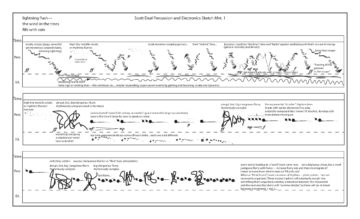
Sketches for a piece by percussion by Elainie Lillios.
They can improvise based on those drawings, and then send the tape back to Lillios. More material to work into the piece.
“It takes me awhile before I get to the notes,” Lillios said.
And when she gets down to the notes she’s more interested in the textures and the tone, the timbres of the music, than the pitches the instruments play.
For about a decade she did not use instruments. She created electronic pieces based on real world sounds – marbles rolling around in a bowl, pots and pans banging together, crinkling paper.
When she returned to composing for instruments in 2007, she brought that same approach with her.
“Now I find I treat my instruments as if they were that piece of crinkly paper. I have to figure out what that sonic potential is. Where’s the intersection between the crinkly paper and a saxophone? How do I bring these two worlds together?”
That interest in sound per se goes back to what first got her hooked on music. One of her friends had a Wurlitzer organ. Lillios was fascinated by the pedals and stops, “all the bells and whistles.” She begged for her own, and the family bought a Hammond organ. “That’s my introduction to timbre.”
Lillios started taking lessons. At 11 her teacher introduced her to composition. She wrote a toccata that won an award. Now 37 years later, she said, she’s still composing.
She has a deadline of September, 2017 to finish “Hazy Moonlight” with a premier anticipated for some time that fall.
Because of additional administrative duties this year, she said she has “scaled back her compositional obligations.”
All her creative energy will flow into “Hazy Moonlight.”
“I want it that way because with the Barlow I want to create a piece that will stand up to the name of the commission, that really fulfills the mission of the Barlow: to promote outstanding musical composition,” Lillios said. “I feel I have my work cut out for me.”


